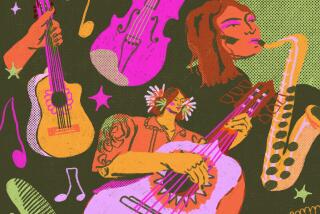Musical Instruments
- Share via
Whether it’s a trumpet fanfare, a drum roll or even a rim shot, musical instruments have played an important role in ancient and modern cultures. The organ that today accompanies both weddings and baseball games is part of a long tradition of using music to enhance ceremonies and rituals, to inspire victories, communicate messages and even promote healing. Learn about the history and production of musical instruments and how they have been used in cultures around the world through these direct links on The Times Launch Point Web site: https://www.latimes.com/launchpoint.
Here are the best sites for getting your schoolwork done or for just having fun.
Level 1
American Symphony Orchestra League: An orchestra consists of string, woodwind, brass and percussion instruments. Listen and view each type of instrument, try interactive musical games and hear how a composer used brass instruments to represent the blazing sun and woodwinds as wiggly Martians in a composition about space travel.
https://www.playmusic.org/
Making Music: You can make maracas with rice and cups or create finger cymbals with the lids of baby-food jars. Create eight musical instruments of your own using easy-to-find materials.
https://familycrafts.about.com/parenting/familycrafts/library/weekly/ aa012599.htm?iam=mt&terms;=children%27s+musical+instruments
Music Education at DataDragon: Steel drums are often used in reggae music while Celtic music features a fiddle and drumming. Listen to various musical instruments and get acquainted with seven styles of music.
https://DataDragon.com/education/
Level 2
Medieval and Renaissance Instruments: How do you play a lizard, a serpent or a zink? This illustrated guide takes you through 32 Renaissance and medieval instruments.
https://www.s-hamilton.k12.ia.us/antiqua/instrumt.html
Musical Instruments of the World: How does an African lute compare to a Japanese shakuhachi flute? Travel the globe and listen to unique musical instruments from places like Asia and the Americas.
https://www.eyeneer.com/World/Instruments/index.html
Zoeller Arts Center: Musical Instruments Encyclopedia: From accordion and balalaika to violin and xylophone, learn about 22 instruments through photos, sounds and historical facts, and test your knowledge with an interactive quiz.
https://www.Lehigh.Edu/zoellner/encyclopedia.html
Level 3
Music Heritage Network: Instrument Encyclopedia: This outstanding site enables you to learn about musical instruments either by instrument type or by country of origin. View photos and listen to clips as you discover the history behind such items as the talking drums of West Africa, which mimic the rhythms and sounds of spoken language.
https://www.si.umich.edu./CHICO/MHN/enclpdia.html
Aboriginal Art & Cultural Centre: Read about ancient aboriginal instruments and learn how to play the Australian didgeridoo, an ancestor of the modern-day trumpet that has counterparts all over the world such as the Swiss alphorn and the South American and African large trumpets.
https://www.aboriginalart.com.au/didgeridoo/dig_intro.html
America’s Shrine to Music Museum: Take a virtual tour of this museum that features photos and historical details on instruments ranging from Tibetan horns and Burmese harps to Stradivari violins and Civil War drums.
https://www.usd.edu/smm/galleries.html
Launch Point is produced by the UC Irvine department of education, which reviews each site for appropriateness and quality. Even so, parents should supervise their children’s use of the Internet. This column was designed by Deenean DeMaio, Quynh Le, Sarah Park and Anna Manring.
EXPLORER’S QUEST
The answer to this Internet quiz can be found in the sites at right.
What special type of breathing is needed to play the didgeridoo?
CLUE: See Zoeller Arts Center: Musical Instruments Encyclopedia
Find What You Need to Know: Have a project on California history? Need help doing a math problem? Launch Point now covers more than 150 topics for getting your schoolwork done. Go to https://www.latimes.com/launchpoint/ for the full list of subjects and direct links to the best Internet sites.
Answer to last week’s Quest: A bee performs a round dance to indicate that a food source is less than 35 feet from the hive.

